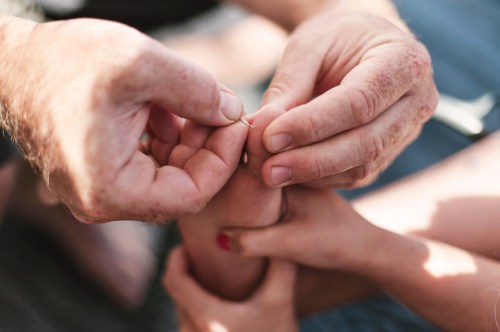Almost all of my friends have some sort of vivid, wince-inducing injury story from when they were younger. One friend has an eyebrow scar from hitting the corner of an AC unit; another got stung on the lip by a bee when she was drinking from her sippy cup. Mine? I have…a few. One that always sticks out to me, though, didn’t actually happen to me. It was when my brother fell into a thorn bush and got the biggest splinter in his knee. He had to head to urgent care to get it taken out, but ever since then, I’ve always wondered what the best practice for removing splinters is.
Experts in This Article
board-certified foot surgeon at Sole Podiatry NYC and star of TLC’s My Feet Are Killing Me
Some two decades later, I got the scoop from podiatrist Brad Schaeffer, DPM, a New York City-based board-certified foot surgeon at Sole Podiatry NYC, and the star of TLC’s “My Feet Are Killing Me.”
Here’s what to do for a splinter, according to a foot surgeon
So, first things first: A splinter occurs when a shard of something lodges into the skin. Splinters are typically tiny pieces of sharp wood that lodge into the skin, though they can also be plastic, glass, or metal. The splinter typically lodges into the epidermis or outer layer of the skin. The deeper the splinter is, the more likely it is to hurt.
1. Cleanse the area
“It is okay to try to remove a splinter by sterilizing the area with alcohol and making sure that you have a sterile pair of tweezers before trying to extract the splinter,” Dr. Schaeffer says. Try to get the splinter out as soon as it lodges into the body so that your skin doesn’t heal around the material. This, among other situations, is when you might need professional attention.
2. Use sterile tweezers (only)
Dr. Schaeffer adds that when trying to remove a splinter, it is important to not use any sharp objects like a blade or any other tools that “bathroom surgeons” like to use at home. You shouldn’t use anything that is not sterile and can possibly cause infection and lead to more serious problems. Tweezers are the ideal tool for a splinter because they are not sharp enough to cause further cuts or damage to the skin like needles or knives—while also providing a very helpful tactile grip. Using a magnifying glass and a bright light on the area while you’re trying to get the splinter out can also be helpful.
3. If you can’t get it out easily, try not to dig into the skin too much
Sometimes splinters are really deep or inaccessible, or your tweezers just aren’t that good. Try not to dig into a splinter wound too much. If you can’t get the splinter out after a few attempts, Dr. Schaeffer says it’s best to clean the area and have a professional take a look.
4. Sanitize, medicate, and bandage the area afterward
If you successfully remove the debris, wash the area with clean, warm water and apply a bandage over the wound. A first-aid antibacterial ointment like Neosporin can be beneficial in the healing process as well, Dr. Schaeffer says.
5. When to seek medical care
If you start to notice redness around the wound, if it feels hot to the touch, or it leaks pus, it’s time to see a medical provider. These are signs of infection that you want to keep an eye on, Dr. Schaeffer says. Additionally, considering the material of the splinter is important. If it is metal or dirty material of some sort, seek medical care if you are not up-to-date on your vaccinations. If the material of the splinter is glass, sometimes it can be hard to tell if you got everything out. Pay attention to additional pain and seek medical care if you feel like there may be residual splinter material in the wound. Additionally, wearing appropriate shoes and not sliding hands on wood can help prevent splinters in the future—because the best way to deal with splinters is to avoid them in the first place.
Sign Up for Our Daily Newsletter
Get all the latest in wellness, trends, food, fitness, beauty, and more delivered right to your inbox.
Got it, you've been added to our email list.











